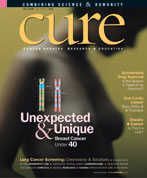Partial Breast Irradiation: A Convenient Alternative
A more local approach to radiation therapy in less time.
A patient-friendly advance in radiation therapy means early-stage breast cancer patients have another treatment option after lumpectomy. For years, the standard treatment after lumpectomy has been whole breast radiation, which has involved external radiation to the entire breast for a period of five to seven weeks. But studies have shown that partial breast irradiation (PBI) can successfully treat the portion of the breast in and around the area where the tumor was removed—all in about a week.
Interest in this targeted method, which can be done in a number of ways, grew out of patient inconvenience and potential side effects (chronic chest wall or breast pain and cardiac toxicity, for example) and was not developed to specifically improve outcome. And though recent study results show that PBI has local control rates similar to whole breast radiation, radiation oncologists point out that it has been well established that lumpectomy with whole breast radiation achieves survival rates equal to mastectomy. Researchers still must determine which patients are most likely to benefit from PBI before its mainstream adoption.
The National Surgical Adjuvant Breast and Bowel Project and the Radiation Therapy Oncology Group are currently recruiting patients for what is expected to be the key study in determining if PBI provides equivalent local tumor control compared with whole breast radiation and who may benefit from PBI. The phase III trial will enroll approximately 3,000 patients, with mature data expected in eight years. The PBI techniques that will be used in the study are described below.
MammoSite. A doctor inserts a tube with a balloon attached to the end into the area where the tumor was removed. The balloon is filled with saline and a radioactive “seed” travels through the tube and into the balloon to deliver the radiation dose. Although the seed is removed after each treatment, the tube and balloon stay in the breast until the 10 treatments over five days are complete. The FDA approved MammoSite in 2002. To locate a treatment center, visit www.proximatherapeutics.com.
Interstitial brachytherapy. Radioactive seeds are delivered through a series of catheters to the lumpectomy area. The number of catheters (tubes) used depends on the size of the breast and the size of the lumpectomy area. As with MammoSite, the seeds are removed after each treatment but the catheters stay in the breast until the 10 treatments over five days are complete.
3-D conformal partial breast irradiation. A pinpointed external beam of radiation delivers the dose to the area of the breast where the tumor was removed.

Extending Healing Commitment to a Cancer Community
April 30th 2024It is Meaghan’s unwavering dedication to supporting children and families during a parent’s illness, along with her willingness to take her direct patient care to practices within her professional position and her community service, that allow me to say Meaghan is truly an extraordinary healer deserving of this honor.
Read More
The Essence of Remarkable Cancer Care
April 29th 2024This year marks the 18th year that CURE and Oncology Nursing News have hosted the Extraordinary Healer Award for Oncology Nursing, which gives people the opportunity to recognize and honor the oncology nurses who have made a significant impact on their life.
Read More